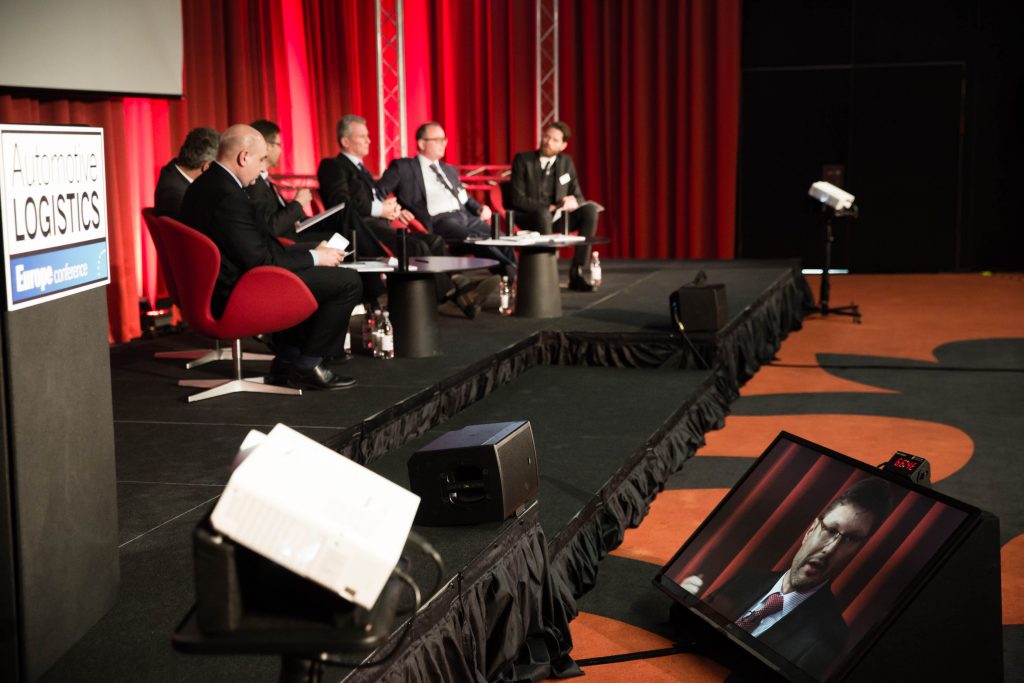 The Automotive Logistics Europe conference set out to capture the Zeitgeist of logistics in terms of technology and skills – and it found that now may be a perfect time to invest in equipment, transport engineering and smart systems. Christopher Ludwig reports from in Bonn, Germany
The Automotive Logistics Europe conference set out to capture the Zeitgeist of logistics in terms of technology and skills – and it found that now may be a perfect time to invest in equipment, transport engineering and smart systems. Christopher Ludwig reports from in Bonn, Germany
Additional contributions by Marcus Williams and Rachael Hogg
 BONN, MARCH 18th, 2016 After years in which the struggling European economy has led to automotive plant closures, business failures among logistics providers and a general sense of industry decline, the region’s and the sector’s fortunes are looking brighter. Last year, the European Union outgrew almost all major markets for light vehicle sales and assembly and the outlook for production and the supply chain sector, despite no shortage of risks, remains good.
BONN, MARCH 18th, 2016 After years in which the struggling European economy has led to automotive plant closures, business failures among logistics providers and a general sense of industry decline, the region’s and the sector’s fortunes are looking brighter. Last year, the European Union outgrew almost all major markets for light vehicle sales and assembly and the outlook for production and the supply chain sector, despite no shortage of risks, remains good.
Europe is now well into its third year of recovery, with sales and output picking up substantially, including double-digit rises in parts of southern Europe and good growth in Germany and the UK, the two largest markets. And more is expected to follow: Christoph Stürmer, global lead analyst for PwC Autofacts, anticipated that light vehicle output will rise across the EU from 18.3m units in 2015 to 19.2m by 2022. In the same  period, the region’s car sales are forecast to grow a further 3m units, rising from 15.8m to 18.8m units.
period, the region’s car sales are forecast to grow a further 3m units, rising from 15.8m to 18.8m units.
For many executives the growth in output in the EU and EFTA countries has resulted in a sharp shift between supply and demand for logistics services. After years in which carmakers struggled with under-utilised production plants and logistics providers made cuts in response to excess capacity in transport, warehousing and other logistics assets, today more manufacturers and providers are scrambling to secure space to move freight and products to market.
“The challenge right now is that we are trying to move from one side of the boat to another, from overcapacity to trying to manage with full capacity, and to balance the demand side with the supply side,” said Peter Weiss, head of supply chain for Europe, Middle East and Africa at Fiat Chrysler  Automobiles. “It's a good problem but it requires supply chain skills.”
Automobiles. “It's a good problem but it requires supply chain skills.”
But while facing up to today’s capacity challenges is once again a major topic in Europe, so too is how manufacturers and logistics providers should adapt to a changing future. Along with political and economic risks – from the refugee crisis to ‘Brexit’ to a slowing China – there are also questions over whether shifts in technology, culture and demographics might fundamentally change demand for car ownership and use in the near future. Likewise, with the increasing move towards digitalisation, autonomous driving and predictive analytics, some wonder if today’s logistics platforms, processes and companies will remain relevant within a decade or two.
Executives and analysts at Automotive Logistics Europe 2016, however, were sanguine about the future and mostly predicted opportunities for growth. While ‘Industry 4.0’ – a term increasingly used to describe how digitally connected technologies will transform manufacturing and industry – could well disrupt many existing companies and processes, most at the event saw new technologies as a means to support and improve their operations, rather than make them redundant.
Capacity demands and complexityPart of the Zeitgeist this year for the European supply chain has been growing demand and supply shortages for inbound logistics, materials handling and outbound distribution. Capacity issues have been most acute in markets now growing strongly – such as Italy and Spain – after years of painful losses, as well as for asset-focused operations such as vehicle logistics. Investment in that capacity has become a “terrible necessity”, according to Hervé Moulin, who oversees vehicle operations and methods for outbound at the Renault-Nissan Alliance.

“There is a strain on our ability to distribute the vehicles we make now,” said Moulin. “In the next few years, the market will continue to grow and we will have more vehicles to distribute. The carmakers will need to rely on the providers that can give them the necessary transport volume.”
Such developments have renewed interest and activity in European automotive logistics. Deborah Buswell, European distribution manager at Jaguar Land Rover, called for outbound carriers to invest further in transport equipment, although she acknowledged that carmakers had to support them in that risk.
“The demand is there and there are significant capacity issues around Europe, so undoubtedly there needs to be investment,” said Buswell, while acknowledging that carriers needed support in financing such expansion. “What we are saying is that we will share in that risk, by giving the right contracts.”
With production rising, such demands are also apparent for inbound transport and parts handling, where the conference revealed much about how complex and intense regional logistics chains had become. In particular, manufacturers have had to respond to more parts variety in plants to support high levels of vehicle customisation, as well as a growth in cross-shipping across Europe and beyond for vehicles that are built with the platform. Carmakers including Ford, General Motors, Renault Nissan and FCA have all seen a rise in the average distance that they ship components, with consequent impacts for logistics networks, transport and duty costs.
Björn Klippel, founder of TIM Consult, which benchmarks logistics costs and processes across companies, pointed to average distances of
Videos
View video recordings of most sessions
News and feature coverage from Bonn
- -Vehicle logistics: Can outbound face old challenges with new technology?
- -Vehicle logistics: OEMs commit to support investments in capacity
- -Changing with the global tides of technology
- -How to solve a problem like complexity
- -Looking to sustainable logistics
- -Change at the heart of the supply chain
- -Logistics is still risky business
- -Leading the fourth revolution
- -How to do more with less in plants
- -Panel discussion: A time for optimism
Carmakers have also seen increases in intercontinental suppliers. “We see that inter-regional and cross-continental logistics flows are rising. For example, at one major OEM who has been growing revenue at a rate of around 5% per year, intercontinental freight by TEU has been increasing by 15% per year,” said Klippel.
According to Klippel, trucking operations have grown strongly across European carmakers. The largest OEMs now ship 300,000-500,000 full truckloads of material per year, and they increasingly contend with border issues, unreliability and a lack of visibility that may result in the need for expedited freight. As an example, Klippel revealed that the top carmakers in Europe are likely to spend around €100m ($112.6m) per year on air freight alone.
Logistics executives confirmed this complex supply chain shape. Lutz Quietmeyer, general manager of inbound logistics at Renault Nissan, pointed to cross-plant production of brands and platforms not only between Renault and Nissan, but also with other Alliance brands such as Dacia and Russia’s Avtovaz, along with a looser alliance with Daimler.
“With our platform strategy the ultimate goal is to share a maximum number of non-visible parts between vehicles,” he said. “We then aim to have parts suppliers close to factories, but if you want to have more and more of the same modules for different vehicles, this doesn't work anymore. You either centralise in one location or build across locations.”
Quietmeyer pointed to examples in Europe for Renault Nissan that included using a shared supply base for common parts between the Renault Kadjar, built in Palencia, Spain, and the Nissan Qashqai, built in the north-east of England in Sunderland. “We’ve had to build up some logistics links to share these parts,” he said.
 Lutz Quietmeyer said the Renault, Nissan, Dacia, Avtovaz and Daimler were increasingly exchanging common parts
Lutz Quietmeyer said the Renault, Nissan, Dacia, Avtovaz and Daimler were increasingly exchanging common parts“We are now in the era of cross-shipping, as we have beefed up the inter-regional flow of materials and cars [for FCA],” said Weiss. “We now have cars built in Mexico and rebadged as Fiat for Europe, and Italian-built Jeeps that we export back to North America.”
Ford of Europe has seen similar growth in parts mileage and intercontinental trade across its supply chain. “At Ford, we are definitely seeing an increase in mileage for the parts and cars that we move, including getting more parts from the Far East and from North America,” said Bert Bong, manager of material flow and supply chain management for Ford of Europe. “With a few products in the US and Europe, we can gain the synergies of scale with one component supplier and ship it from Europe, and the other way around.”
At Ford, at least, there has been a similar growth in mileage for outbound vehicle distribution, especially as it has increased imports into Europe from North America and India. “We are also cross-shipping more finished vehicles as well, whether imports from North America with the Ford Mustang from the US, or the Edge from Canada, or the Ford Ecosport from India,” he said. “The result of this increasing mileage of parts and cars is that we are expecting a rise in customs and duty costs of around five times over the next five years.”
Jörg Blechinger, director of Magna Logistics Europe, confirmed that the growth in transport complexity was evident among large tier suppliers as well. He explained that Magna had gone from having 65 European plants in 2005 to 114 in 2016, while from 60,000 active parts the company now deals with 170,000; meanwhile, the company has gone from moving 18,000 conveyances per week a decade ago to 40,000 per week last year. He pointed to international flows as well, including those that move from Mexico to Europe and Russia.
 FCA's Peter Weiss said that logistics costs had fallen thanks to better planning, as well as low fuel prices and new competition among providers
FCA's Peter Weiss said that logistics costs had fallen thanks to better planning, as well as low fuel prices and new competition among providersKeeping logistics cost downDespite the rising complexity, mileage and variation in the supply chain, logistics executives confirm that the overall cost of logistics as a share of total vehicle cost has fallen for the European sector. Luc Nadal, chairman of the Gefco Group, pointed to a constant focus on route design, container and packaging engineering and filling truckloads and milkruns as a means to achieve these cost reductions.
“We are doing more frequent engineering and also being asked to do logistics simulations by our customers to help plan and control costs in advance. In that way, we can find the right logistics balance within the supplier footprint,” he said. “We also have a lot more we can do on the outbound side to reduce inventory of vehicles.”
Andreas Ginkel, director of alliance logistics for Opel/Vauxhall, which uses Gefco as a 4PL in Europe, confirmed that logistics as a share of cost had fallen at GM over the last three or four years. Ginkel credited the drop to more focus on total cost approaches to sourcing and especially “front loading” planning in the years ahead of a model launch. “That includes working together with engineering to make sure that we make the right decisions on how we transport or build parts,” he said. “My favourite example is a long exhaust system, where you can have huge impacts on the total cost in deciding how you break down the part for more efficient transport.”
Peter Weiss from FCA agreed that the relative costs of logistics had been dropping. He also credited logistics engineering and upfront planning for routing and packaging. However, Weiss added that the drop in fuel prices should also not be forgotten, while new entrants in the logistics market had kept competition high and costs low.
Björn Klippel pointed to different ways that carmakers have engineered or re-engineered plants to manage rising logistics complexity. At older plants, especially in Germany and the UK, space to expand is limited or prohibitively expensive. In those plants, manufacturers tend to focus on finding ways to handle more material in a limited space, whether through specialised packaging, more flexible equipment or by outsourcing more to tier suppliers. In newer, larger plants in eastern Europe, on the other hand, more space tends to be dedicated to parts handling and optimal line feeding.
 Ford has benchmarked other OEMs to help it come up with a new approach to line side kitting at its Valencia plant, said Axel van het Kaar
Ford has benchmarked other OEMs to help it come up with a new approach to line side kitting at its Valencia plant, said Axel van het KaarA good example of how logistics has been reorganised is Ford’s upgraded Valencia plant, which now builds five different models across two assembly lines. The increase in part numbers and variety has necessitated a different approach to handling delivered parts. In particular, it is no longer feasible to deliver as many parts and components straight to the line side as when the plant had one line, or to do as much traditional sequencing. Ford has invested in a new kitting strategy, including developing new packaging, according to Axel van het Kaar, carline supervisor for material flow and packaging engineering at the carmaker.
“We benchmarked other OEMs to look at kitting concepts, as we had a big challenge in how to find space to kit parts and manage complexity within an old plant,” said van het Kaar. “We did a lot of good design work to come up with a single box as a kit. For example, although there is a lot of variation with the door trim when you have five different models, we use a box that can handle the parts for any of the models.”
Risks and rewardsWhile the European industry is perhaps the healthiest it has been in a decade or more, a number of risks and questions still hang over the wider region, with implications for the automotive trade. Further economic and political disruption cannot be ignored, especially with unemployment still chronically high in France and in southern Europe, economies still weak and government spending under pressure.
The refugee crisis and the tightening of border controls in south-east Europe, which has raised doubts over the passport-free Schengen Zone, could threaten the smooth flow of material and products across European borders. Russia’s own economic mess, its strained relationship with Europe and the crisis with Ukraine have decimated the current market and dampened its long-term prospects for growth and trade with Europe.
The looming referendum for Britain’s EU membership, set for this June, also has some investors and companies worried over the implications for its important trade with Europe, including automotive imports and exports.
In the long term, analysts have also pointed to changing demographics and attitudes to vehicle use that could mean the automotive industry will see further drops in volume over the coming years and decades, as urban dwellers in particular move towards a greater range of mobility options from public transport to shared car usage. Some predict the eventual rollout of autonomous vehicles will only accelerate this shift away from private vehicle ownership.
However, on most of these fronts the the analysts and experts the conference heard from were generally optimistic about the industry’s prospects.
PwC’s Christoph Stürmer said that the risks of contagion from global economic issues were so far mitigated in Europe by loose monetary policy, low financing, extremely low inflation and cheap fuel. Worries over China have so far proved overblown, he added, especially for vehicle sales which are still expanding at 6-8% per year.
Stürmer also said he wasn’t losing too much sleep over the possibility of ‘Brexit’, citing a range of scenarios in which the UK would mostly keep access to European markets. He did note that the country’s current position within the EU, but outside the euro and Schengen, had been serving the automotive industry well. “Even in my worst nightmare I could not imagine the UK really withdrawing into ‘splendid isolation’ from Europe,” he said.
Looking further out, and considering wider technological changes, others at the conference were optimistic. Matthias Kässer, from management consultants Mckinsey & Company, saw mega-trends such as vehicle connectivity, digitalisation, autonomous driving and the ‘internet of things’ as ultimately having a positive impact for the world’s carmakers.
For example, while shared mobility options would likely increase in cities, Kässer said he expected it would only slow growth in new vehicle sales slightly. He suggested global annual vehicle sales would still increase from 87m units last to year to 115m in 2030 – of which about 10m would be part of shared fleets of cars. McKinsey also foresees that extra revenue from connected vehicles – including in e-commerce and software – will more than compensate for any slowdown in expansion in private driving.
 Analysts including PwC’s Christoph Stürmer were generally optimistic about prospects for the European sector
Analysts including PwC’s Christoph Stürmer were generally optimistic about prospects for the European sector“Driven by shared mobility, connectivity services and feature upgrades, new business models could expand automotive revenue pools by as much as 30%, or an extra $1.5 trillion by 2030,” said Kässer.
Kässer also predicted that autonomous vehicles could represent around 15% of the new vehicle market by 2030, depending on regulatory and technological developments. The percentage could increase dramatically after then, but would depend on technical and legal factors as well as consumer acceptance, he stressed. However, he did not forecast the end of the age of high car production and consumption. Meanwhile, the role that European carmakers are expected to play in developing and refining autonomous technology should support them growing and benefitting as driverless features increase, he said.
Industry participants were also optimistic about the prospects of this technology for automotive logistics, including for the varied supply chain that it would itself require. Michael Martin, vice-president of strategic development for the global automotive sector at DHL Supply Chain, pointed out how the automotive and high-tech sectors were converging, with a premium car today carrying the equivalent of more than 50 computers in it. The implications for logistics have included a range of new suppliers – sometimes in far-flung regions – and parts, with more sequencing and other techniques involved.
 "Driven by shared mobility, connectivity services and feature upgrades, new business models could expand automotive revenue pools by as much as 30%, or an extra $1.5 trillion by 2030" - Matthias Kässer, Mckinsey & Company
"Driven by shared mobility, connectivity services and feature upgrades, new business models could expand automotive revenue pools by as much as 30%, or an extra $1.5 trillion by 2030" - Matthias Kässer, Mckinsey & Company
Both Kässer and Stürmer were also positive about the role that European technology and production could have in a future where more cars will be based on electric powertrains. Although the current sales rate for electric vehicles remains low, Kässer believes the industry will move further towards electrification, driven in large part by increasing regulation.
If so, Europe’s production base is likely to benefit. Along with having established electric car production in a number of countries including the UK and France, carmakers are increasing their electric offerings. Stürmer pointed out that Audi will build an all-electric model at its factory in Belgium by 2018, while Volkswagen will also re-engineer its factory in Dresden to build electric vehicles.
OEM executives at the event also said they expected a greater role for electrification in their production and supply networks. Bert Bong from Ford pointed to studies suggesting electric powertrains would be priced competitively with diesel ones by as early as 2020-2022. Ford has already announced billions of dollars in investment to offer more electric options, with plans to offer electrification for 40% of all its models by the end of the decade, he said.
FCA’s Peter Weiss also pointed to the new models and technology unveiled at the recent Geneva motor show as evidence that the internal combustion engine might be replaced by electric and alternative fuels over the next decade. Before then, however, he expected to see more options for greener and alternative fuels, both in the passenger car and logistics sectors. He pointed to the need for more interest and investment in both compressed natural gas (CNG) and liquefied natural gas (LNG) – something that FCA has already invested in for its in-house trucking fleet in North America.
Supply chain updates available‘Industry 4.0’ (and its impacts for the supply chain) was also speculated upon by many speakers, even if some of its concepts and technology may still be years away from being visible in automotive logistics. However, changes are already evident with much more expected to come, especially in areas like big data, cyber-physical systems, smart devices, the internet of things, advanced automation and cloud computing.
 Christian Schwede of Fraunhofer IML: connected technology and automation will become much more prevalent
Christian Schwede of Fraunhofer IML: connected technology and automation will become much more prevalentChristian Schwede, head of department at Fraunhofer IML, Europe’s largest industry research organisation, pointed to the connected technology and automation that more manufacturers are already using, notably automated guided vehicles (AGVs) in plants and warehouses. He predicted that many areas of the supply chain and its workers would see such technology help increase productivity and visibility.
Schwede gave the examples of racking systems that could order supplies autonomously; bins that would know their own contents and control processes; containers that could organise loads and routes on their own; and trucks transporting goods without a driver. All of these technologies are to some degree already possible and are expected to become features of the supply chain over the next decade or more.
Schwede also described the potential of more connected factories and supply chains to address chronic inefficiencies, such as imbalances in inventory, as production was tied much more closely to real-time demand. Rather than programming all production in fixed cycle times to feed the plant machine, cycle times would be determined by algorithms that took into account actual orders, the density of volume, the distances of the supply base and delivery time. The production plant and the supply chain would have more decentralised features, with far more potential to be flexible to changing orders.
Technological changes were also discussed for outbound logistics. As well as the opportunity to lower vehicle stocks thanks to more customer-driven demand, real-time communication and tracking is expected to become the norm. Michael Gorny, manager of vehicle planning logistics for Opel/Vauxhall, said that GM, along with others, was starting to explore how it could use a vehicle’s telematics systems to track and execute decisions in the supply chain, such as in response to remote readings of a vehicle’s battery status or tyre pressure. The company is also rolling out RFID scanning at plant yards in Europe, beginning in Eisenach, Germany.
“HMI (human-machine interface) is increasing,” he said “Our cars will not only provide good data but communicate it better. There is also real-time connectivity in the value chain networks.”
 Opel's Michael Gorny predicts that the automotive industry will move deeper into human-machine interfaces
Opel's Michael Gorny predicts that the automotive industry will move deeper into human-machine interfacesJLR’s Deborah Buswell, however, who outlined the carmaker’s own trials with telematics at the conference last year, said that the industry was going to need to establish standards if it were really going to be able to harness the potential of in-vehicle telematics.
“Telematics will assist in illuminating the way and accelerating the processes. It will eliminate manual intervention,” she said “It is in its infancy but I think it can assist, and the more available we make it, and the more standardised we make the transfer of knowledge and data, the better.”
Industry 4.0 and further digitalisation in the supply chain are expected to have impacts for the automotive aftermarket as well, especially as companies use ‘big data’ methods to analyse demand and logistics patterns. Michael Martin at DHL Supply Chain pointed out that such analytics, along with real-time visibility supported by telematics and remote diagnostics, could help carmakers better predict parts needs. A connected car could help to integrate scheduling of servicing with daily parts deliveries and reduce the waste of unnecessarily replacing parts. As a result, vehicle uptime could be increased by 30%, Martin suggested.
Zeitgeist is not always the ZukunftExcitement around the potential for such services and developments was palpable, as executives saw the potential to improve their operations and keep up with a fast-changing world. However, as much as such technology may capture the Zeitgeist of logistics today – the theme of this year’s conference – there was plenty to suggest that the industry still has plenty of room to improve ‘Industry 3.0’.
 Michael Bünning said only eight EU member states and Switzerland had currently adopted the e-CMR
Michael Bünning said only eight EU member states and Switzerland had currently adopted the e-CMRFor example, BLG Logistics managing director Michael Bünning pointed out how, despite the EU having officially approved a digital version of the CMR Protocol, the standard delivery note used in Europe, only eight EU member states and Switzerland have adopted the e-CMR. Among those that haven’t adopted it is Germany, the bloc’s largest market. If the e-CMR has not been adopted in either the origin or destination country, then it cannot be used in either. “For most operations, the e-CMR therefore remains only a theory,” he said.
Bünning also pointed to slow progress in member states putting similar digital protocols into practice to support rail and maritime freight. He called on logistics providers and carmakers to work together and lobby their national governments to get on with adopting the systems and establishing legal frameworks to allow companies to use them.
Some speakers called on the industry to spend less time theorising over the future and more time focusing on key problems of the day, whether it be physical capacity requirements or learning to work more closely with suppliers and logistics providers across the supply chain.
Stephan Freichel, a professor at Cologne University of Applied Sciences and long-standing logistics industry veteran, said that carmakers should evaluate their own processes much more carefully. For example, he questioned whether ‘lean’ inventory strategies in plants were a genuine example of reducing unnecessary stock or just an example of the problem being pushed out to someone else – whether a tier supplier or logistics provider.
“Before we talk about industry 4.0, we need to talk about the simple stuff, such as making sure you have the right communication and understanding of your supply chain,” he said. “It doesn’t make sense to just beat up and change logistics providers every year.”
"We have more data and order fulfilment than other industries, but we have yet to find the golden ticket in how we can utilise the business intelligence behind this" - Peter Weiss, Fiat Chrysler Automobiles
Peter Weiss from FCA also pointed to the gaps in vision versus reality for aspects of the industry. While companies like Amazon and eBay have revolutionised many aspects of shopping and retail over the last 15 years, there has been less development in how automotive logistics operates. “It is still incomprehensible to me that you can order a piece of soap and get more transparency at Amazon than when you order a vehicle,” he said.
He put part of the blame on a lack of willingness to share information and standardise more aspects of the supply chain across companies. While the high-tech business had largely moved to standard charges or other equipment between products, carmakers tended to keep a tight hold on proprietary systems and components, he said; for example, most still have their own individual connectors for wiring harnesses.
 Ford's Bert Bong (on screen) predicted the electro-mobility would play a more important role in the supply chain in the coming years
Ford's Bert Bong (on screen) predicted the electro-mobility would play a more important role in the supply chain in the coming years“That tells us something about how we don’t work together,” said Weiss. “We have more data and order fulfilment than other industries, but we have yet to find the golden ticket in how we can utilise the business intelligence behind this.”
He suggested that the European industry needed to work together more closely to develop the standards in data, transport equipment and processes that would support more transparency in the supply chain. He acknowledged some progress in the outbound chain, however, where carmakers have agreed to start work more closely with logistics providers specifically on sharing more standards.
“That is exactly what the Automotive Logistics Europe conference platform should also lead to,” he said.
Automotive Logistics Europe is part of the global Automotive Logistics series of conferences.
The next conference in the series is Automotive Logistics China in Chengdu, on April 19-21st.
The next conference to be held in Europe will be Automotive Logistics Russia in Moscow, on June 28-29th.
Topics
- Africa
- africa
- asia
- Asia
- Automotive Logistics Europe
- Brexit
- Europe
- europe
- features
- Finished Vehicle Logistics
- finished vehicle logistics
- GM
- Inbound
- Industry 4.0
- In-plant logistics
- Intermodal
- Inventory management
- IT
- Manufacturing
- Middle East
- middle east
- Nissan
- North America
- north america
- OEMs
- SCM
- Tier suppliers
- Trucking
- Zeitgeist

























![Global[1]](https://d3n5uof8vony13.cloudfront.net/Pictures/web/a/d/s/global1_726550.svgz)













